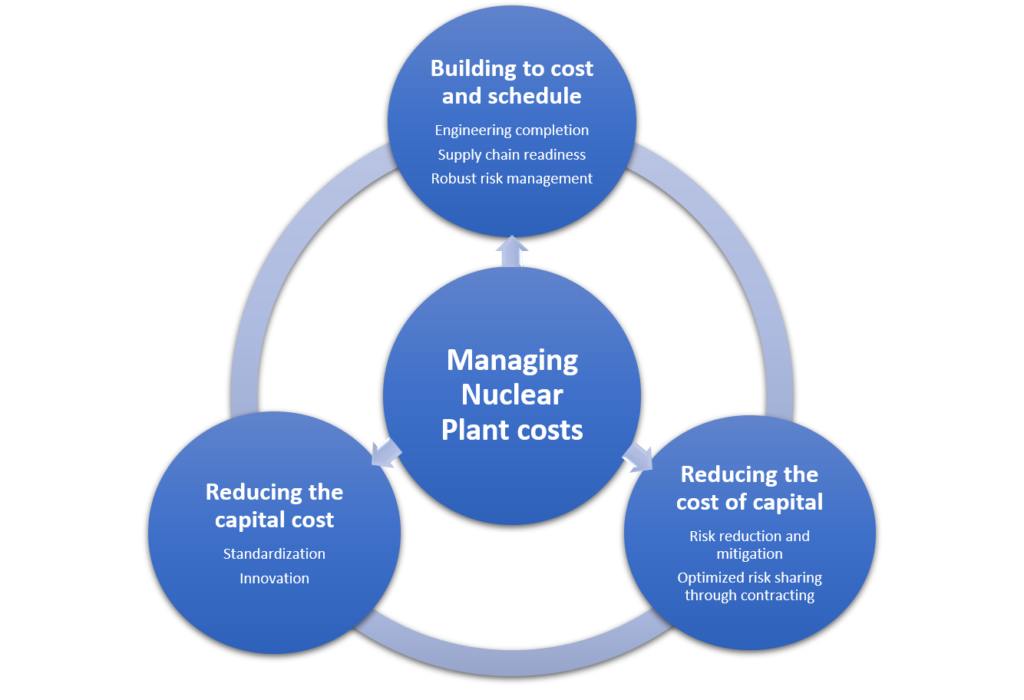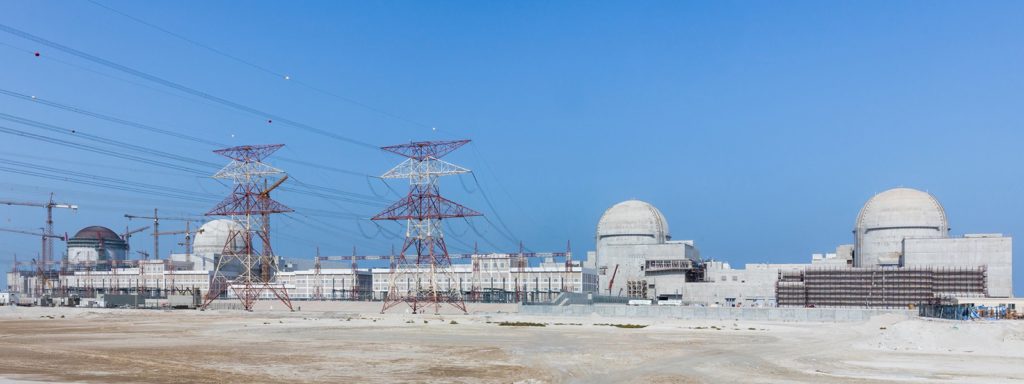Making nuclear plants cost less – build and repeat, the benefit of standardization
When it comes to nuclear project implementation there is no greater challenge than getting the costs right. The industry can focus on improving public acceptance and demonstrating a need for low carbon generation, but only a cost competitive nuclear industry will really meet its full potential. This is the third part of our 3-part series on managing nuclear costs. The first part focused on the need to build to cost and schedule (March 2018) avoiding the severe overruns that have been experienced in the past. The second part considered how to bring down the cost of capital (July 2018), which can be shown to be the most sensitive parameter when considering the cost of energy from a nuclear plant. In this final part, we will focus on the very root of the nuclear cost structure, the capital cost of building a new plant and how to reduce it, primarily through standardization.
We need to look no further than nuclear construction in China and Korea to see how nuclear can be done right. Building a fleet of plants of the same design is paramount to reducing risk and managing cost. There is little doubt that standardizing plant designs and building the same plant over and over reduces both risk and cost. Risks are reduced by doing what has been done before and is well understood, and costs are reduced by learning by doing – or simply getting better at doing the same thing over and over again.
Often, we limit the definition of a standard plant to repeating the same design for a series of projects. However, to get the maximum benefit, it must be thought of in much broader terms. Any change, no matter how small introduces risk that can negatively impact the outcome. The ultimate in standard plant construction is when an exact replica is built on the same site as the previous project. This means using the same design and drawings, the same suppliers of both equipment and construction, the same commercial structure, the same project management approach, and most of all using the very same people who did the work the last time, all in a time frame that maximizes the continuity of what was done before. This is no surprise. Keep in mind that success is all about people. We all know that when we want to do something at home, we have the world’s best teacher in YouTube to show us how to do whatever we are doing. But we also know, that no matter how well we are instructed, we still do better when we do the job for the second time.
Barakah Nuclear Power Plant – United Arab Emirates
Evidence shows that huge gains can be made replicating at the same site. The ETI (Energy Technology Institute) report on nuclear cost drivers notes that early units have higher costs for the Barakah project and later units have significantly lower costs through both multi-unit efficiencies and learning effects (The final unit is about 40% less cost than the overall site average cost). However, once we leave a given site, replication benefits start to be reduced. In the same jurisdiction we are likely to closely replicate what has been done at one site to another although different site conditions will have to be considered. In a second jurisdiction, where there may be new project managers, new suppliers and new site conditions, more challenges arise. It is essential to maximize what is replicated and minimize what is not. Of course, moving around the world, we know the challenges. Re-localizing the same components and services for each new market is a recipe for added risk. A model where we globalize supply would be much better so that the same suppliers can have the same scope in many different jurisdictions. However, political reality makes this difficult. The next best thing is to use the same design and then do our best as an industry to institutionalize the processes so that new suppliers and contractors can replicate what has been done by others with appropriate learning methods to ensure the benefits of replicating can be maximized.
Once we are focused on replicating standard plants, we can then further improve costs by innovating. It seems counter intuitive since innovation means change, and change means moving away from the standard. While true, the key to success is modest and managed change within the construct of a standard plant. As we learn, and new technologies become available, we can innovate through improved methods and smarter design.
A 2016 study by McKinsey found that productivity in the construction industry is poor compared to other industries for a range of reasons. One is the slow adoption of digital technologies into the field. Using technologies found in other industries to improve construction in general and nuclear project implementation specifically can make a huge difference. Anything that improves the cost and reduces time and risk is worth considering. This does not mean huge design changes but rather project management and construction improvements. Construction of large projects means managing large amounts of information and ensuring modern information management techniques are used by this industry will bring obvious benefits.
Design changes need to come as well but based on learnings from a series of plants. The big issue is whether or not we can achieve the volume of projects required to build a series, make changes and then implement an updated model for a new series of projects. This is what the French did in the past and the Chinese are going down this path with their large domestic program. As seen above at Barakah, the Koreans have been masters at developing and implementing standard plants.
The bottom line is that lower costs are a key driver for future industry success with improvement not only being possible, but well within reach of the industry. If we pay attention to all three paths to cost reduction, i.e. ensure projects are built to cost and schedule, reduce the cost of capital through more realistic risk management, and reduce the cost of building plants through standardization with innovation in construction methods, the result will be significantly lower costs of energy (likely anywhere from 25 to 50%) than are being realized in western countries today. This would be a game changer.
As nuclear power becomes recognized as the only large-scale generation option that meets both environmental and reliability requirements for an energy hungry world, there is no better way to get the world to accept nuclear than bringing down the cost of energy.







5 Comments
Mark · November 22, 2018 at 3:53 pm
Amen to that, Milt! Well described. Now how can we convince the engineers to leave the well enough alone and keep replicating s standard design (albeit with any slight changes that must conform and pass economic assessment)?
Phil Weyenberg · November 23, 2018 at 2:04 pm
The big question is What Design? A generation 3 light water reactor? Or a generation 4 molten salt reactor? I believe it’s time to move on to a new more cost competitive design that can be manufactured in a factory and delivered to the site.
Jamie Irwin · November 25, 2018 at 1:52 pm
Factory built is not a guarantee of reduced costs. The final product generally determines that. You can get a factory-built Lamborghini that will still be pretty pricey. We have to decide which system best meets our needs and doesn’t go overboard on luxury items that add little or no value in terms of operational efficiency and safety. Unfortunately, our regulatory environment often dictates that you shall have those luxury items regardless of whether you want (or need) them.
Jamie Irwin · November 25, 2018 at 2:03 pm
Is not Palo Verde an example of this? Three units essentially cookie-cutter on the same site. How well did PV come in based on budget and schedule? There were other places as well that were planned for multiple identical units. Davis-Besse, for example, whose original name was Blue Heron (a drawing of which at one time was portrayed on many station documents), had at least one more unit planned for the site. Likewise Perry was a multiple unit site that ditched its second unit when it was partially complete. In both cases, the cost of the first (and only) unit blew up the budget, so they quit with one. There’s a bunch of them, TMI, Sequoyah, Peach Bottom 2 and 3, and others, I’m sure. Anyone have data handy on how well those did for budget and schedule?
Don’t get me wrong, standardization is a good way to go, but it may not be the answer to the cost issues. If you’ve got budget-busting issues with one unit, you’ll probably have them with multiple units. From what I’ve read of the VC Summer debacle, there were problems with, among other things, good old basic construction management, things like unproductive work scheduling, unproductive personnel on site, unwillingness to take on these issues for whatever reasons (politics, unions, whatever).
mzconsultinginc.com | The importance of strong and effective project oversight to project success · January 24, 2019 at 12:30 pm
[…] on how to build to cost and schedule, how to control the cost of capital and finally, how to control the capital cost. Today we are going to focus on an essential element of managing large projects to cost and […]
Comments are closed.